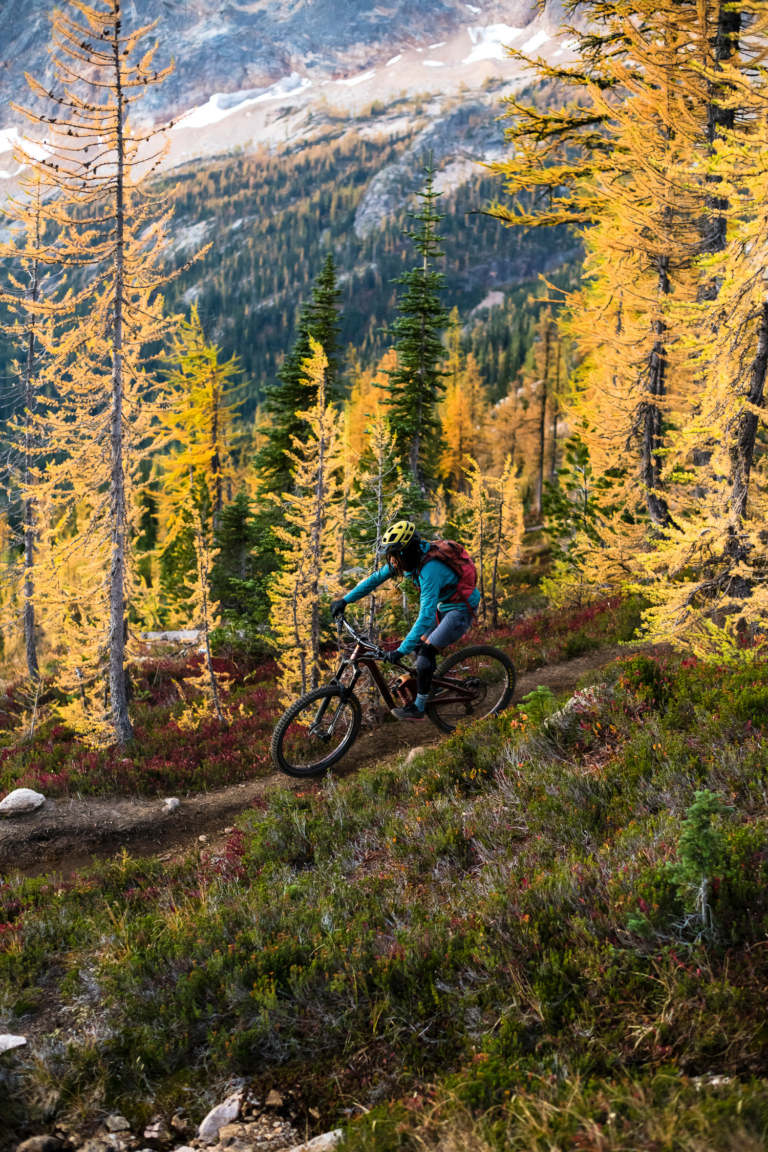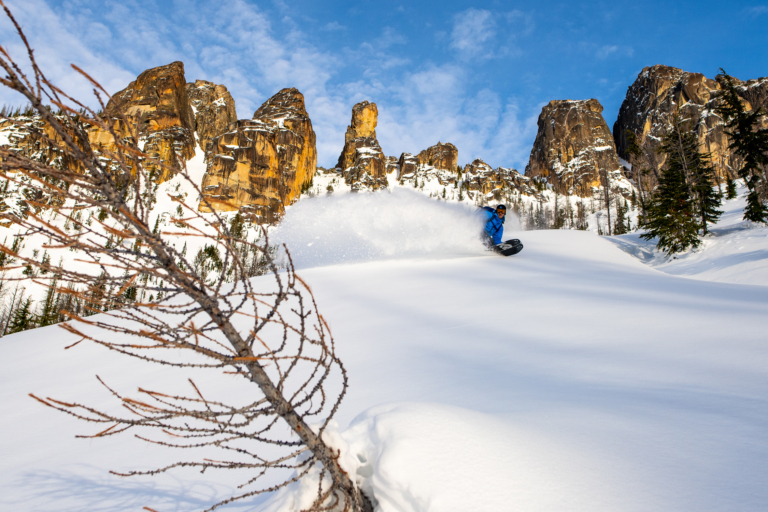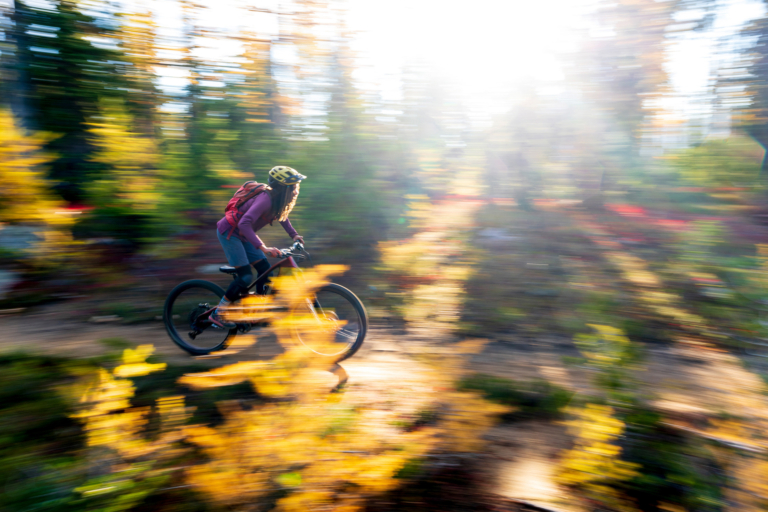Larch Love
An ode to Larix lyallii.
All photos by Colin Wiseman
The subalpine larch is a survivor. It’s a pioneer of a tree, inhabiting altitudes and soils that few other species can tolerate. It lays roots in cold, acidic, windy, wet and snowy environs, which are often dramatic and resplendent. Passing through the warmth of larch needles along challenging tread is a fleeting delight during Larix lyallii’s brief annual splendor, as is gazing upon their fiery façade hugging the nooks and crannies of near-vertical metamorphic rock.

For perhaps an hour after sunrise in early October, the thick autumn sun shines like fire through the delicate yellow larch needles and turns the North Cascades into a world of honey gold. Brooklyn pedals through a gilded alpine landscape on Cutthroat Pass.
Limited mostly to a few parts of the northern Rockies, from Montana and Idaho into British Columbia and Alberta, subalpine larch thrive from 5,800 feet to as high as 9,900 feet above sea level. But in Washington state’s North Cascades Range, a small, disjunct population of Larix lyallii sits alone, guarding an alpine landscape of scree, ice and rock on the east side of the mountains. Unlike most conifers, larch trees—including the subalpine larch—shed most of their needles each fall in order to preserve nutrients for use in milder months, to allow snow and ice to slide easily off their branches and to protect against pests and disease.
For two to three weeks in late September and early October—known locally as “larch season”—these relatively rare deciduous conifers turn the treeline above the Methow Valley a deep amber, transforming alpine hiking and mountain biking trails into chartreuse tunnels. The colors attract photographers, backpackers, cyclists and highway-borne tourists alike.
To move beneath their boughs when the sun sits low on the horizon is to be immersed in an otherworldly glow: delicate, delightful, a world of honey and gold.

The trees aren’t the only fall attraction in the North Cascades; the entire subalpine zone is awash in a spectrum of greens, reds and oranges, made even more dramatic by the range’s dizzying vertical relief. Brooklyn nears the summit of Cutthroat Pass, at over 6,800 feet above sea level.
But Larix lyallii is a tough tree if there ever was one. Maxing out around 50 feet tall, a subalpine larch maintains a diminutive stature, bent by heavy winds with thin, knobby branches, modest girth and slender needles. It’s also one of the longest living tree species, with known specimens estimated at well over 1,000 years old. Their growing season lasts around 90 days, and they need full sun to thrive. Highly resistant to disease and insects, subalpine larch take 100–200 years before they even begin to reproduce.
Though the tree appears half-dead for most of the winter, its place in the natural world is surrounded by life. They provide shelter for mountain goats, hoary marmots, and black and grizzly bears—the ursine creatures like to hibernate beneath their boughs—and nesting sites for alpine birds. Some, like blue grouse, feed on their needles. Elk, mule deer, squirrels, and snowshoe hares all forage among Larix lyallii stands.
Then come the first winter storms. The crowds diminish. The highway closes due to avalanche danger. It gets very, very cold.

Highway 20 cuts through the center of North Cascades National Park, meaning the majority of trails along its length are off limits to mountain bikers. Cutthroat Pass is the one exception, and for those willing to make the 2,300-foot climb, it’s one of the most spectacular fall rides in the state.

Even for seasoned pow-seekers like Kael, Highway 20 in is a brutal place during the winter: Passing under 27 avalanche chutes, the average annual snowfall along the highway exceeds 400 inches and overnight temps regularly drop below 0 degrees Fahrenheit. That’s just fine for subalpine larch, which shed their needles to sequester nutrients and keep heavy snow loads from damaging their boughs, among other reasons. Washington Pass, Washington.
Dendrologists believe that modern subalpine larch populations—including those found in the North Cascades—are survivors of a colder epoch, and the species was once wider spread when the Earth was cooler. And reaching these larch stands during winter takes considerable effort. They often sit 10 or 15 miles from the nearest snow-free roads. But, when the conditions allow, the area’s open bowls and couloirs—some punctuated by a lonely larch or two—see relatively few tracks compared to the more easily-accessible backcountry playgrounds on the west side of the Cascades. There, well-spaced tree runs start amongst larch-covered ridgelines and roll down into thicker, evergreen forests. The larch plays a role here, too: Just as their roots help defend against erosion, their spindly mass serves as a snow anchor, helping limit avalanche activity at times—although these diminutive trees are no match for the handful of massive slide paths slicing through the glacially carved landscape.
Traveling amongst the larches in the depths of winter comes with its own unique reward. The golden needles recede to a burnt umber and a few still hang from their branches. Some bow upward out of the snowpack, even as it grows deeper with each storm. Small, fragrant cones cling to mature specimens. Occasional birds still flit from tree to tree, but for the most part, it’s quiet.

Kael finds a few turns below the granite spires of Liberty Bell Mountain, an iconic cluster of peaks perched above the summit of Washington Pass on Highway 20. Liberty Bell is famous for its rock climbing, but the spring powder turns are just as worthy.
Then the warmth of spring returns. Highway 20 is a favorite spot for Washingtonians seeking late spring and early summer turns beyond the glaciated volcanoes, and once the road opens in May, ski-borne travelers become much more frequent. The larches offer easy passage due to their wide spacing, with fresh yellow-green needles sprouting only as the snow melts in May and June.
Yet the springs and summers in the North Cascades are, as elsewhere, getting warmer. Due to their slow rate of growth and reluctant reproduction, Larix lyallii cannot ascend fast enough to keep up with climate change. They were recently added to the IUCN Red List of Threatened Species.
According to a recent report, the continued warming trend will likely eliminate subalpine larches from the Western United States through competitive exclusion—faster growing evergreens will ascend into the habitat of the subalpine larch and overtake them. The subalpine larch’s hardiness will no longer provide them exclusive purvey of the upper elevations of forested land.
Those warming temperatures will have done what wind, snow and altitude could not. By the end of the century, the subalpine larch could be a distant memory, replaced by evergreen-clad mountains that once held ribbons of gold, if only for a moment.

Brooklyn speeds through a world of red, green and gold on her way down Cutthroat Pass, keeping her eyes up for the many hikers and horse riders who also frequent the trail.


